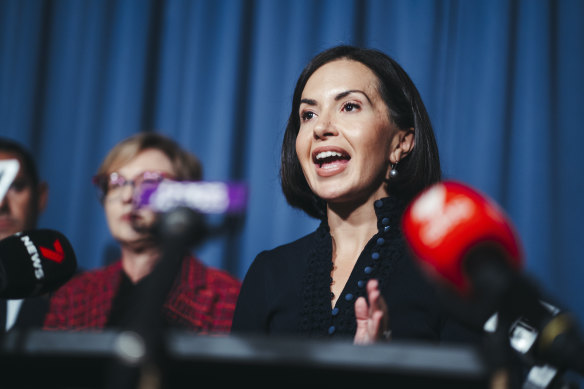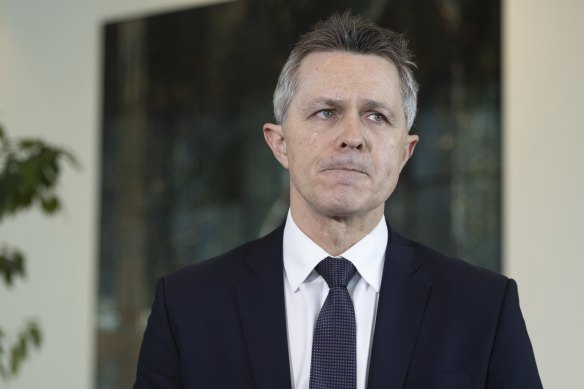By Christopher Harris and Lucy Carroll
The NSW education minister has rejected a $4.1 billion increase in federal funding for the state’s public schools because she says it would set up students for ongoing disadvantage in the decade to come.
The stand-off over more money comes as the total number of NSW permanent and temporary teachers has declined despite a historic pay rise designed to retain and attract staff.

NSW Education Minister Prue Car has refused to sign a new funding deal with the federal government.Credit: Dion Georgopoulos
NSW Education Minister Prue Car on Friday formally rejected the federal government offer of an extra $400 million for the state’s public schools each year, which would lift the Commonwealth’s funding share to 22.5 per cent of the schooling resource standard.
“We remain resolute in refusing to accept an offer that sets our public school students up for ongoing disadvantage and a widening funding gap,” Car said.
In addition to extra cash for schools, the 10-year Better and Fairer Schools Agreement on the table would also give states targets to cut the number of students who fail NAPLAN by 10 per cent. It also mandates maths and phonics screening tests for all year 1 students.
Tasmania agreed to the deal on Wednesday, joining Western Australia and the Northern Territory. Other states including South Australia and Victoria have so far refused to sign.
Along with NSW, they are demanding double the current amount of cash – 25 per cent of the school resourcing standard – which for NSW would be $8.1 billion over 10 years, double the current offer. NSW has agreed to lift its share of funding from 72 to 75 per cent of the total amount.

Jason Clare says the $4.1 billion for NSW is there when it wants it.Credit: Alex Ellinghausen
Federal Education Minister Jason Clare said: “I want to reach similar agreements with the remaining jurisdictions.”
NSW’s bargaining position may be significantly weakened as before the state election, Premier Chris Minns said if the federal government did not fund 25 per cent of the school resourcing standard that, “we will make up the difference”.
The stoush over funding comes after NSW public school teachers were given a historic pay rise which the government said would go some way to addressing the chronic teacher shortage.
In that time, the number of full-time equivalent permanent and temporary staff fell to 65,153 – a reduction of 200 over two years, according to Department of Education figures.
Following inquiries from the Herald, the minister’s office provided data that more shifts were now being done by casual teachers, which swelled to 5104 full-time equivalent staff in 2024. The increase of 400 extra casual teachers meant the total teaching workforce had grown to 70,258.
Opposition education spokeswoman Sarah Mitchell said the drop in the total permanent and temporary staff was incredibly concerning as they came after school budgets were being slashed and support staff and resources have been stripped out of classrooms, increasing workload for teachers.
“The minister said before the election that Labor’s policies would bring more teachers into public schools and reduce teacher workload, and they are failing to live up to this promise,” she said.
Asked about the administrative burden, Car took aim at the former government.
“We are working with the NSW Teachers Federation to ensure teachers are relieved of the unnecessary administrative burden that exploded under 12 years of mismanagement by the Liberals and Nationals,” she said.
“This is a top priority, and while it won’t be fixed overnight we have already made inroads to address the significant issue of workload.”
One school principal, who spoke on the condition of anonymity because they are banned from talking to the media, said public school teachers were leaving for private schools because they would be paid more, there was less busywork, and there was not the concentration of students with complex needs.
“One of the things about teaching is you do have to adjust lessons for the top and the bottom. The private schools don’t have as many of those complex kids,” she said.
“We get these kids who are highly complex, so the teachers have to do all this extra work.”
University of Melbourne global education expert Professor Pasi Sahlberg said the department should be investing more in experts in schools who would be able to take some of this administrative load linked to the individual plans of the students with disabilities.
“This is what many other countries are doing. There are more non-teaching staff in schools.
“The actual classroom teaching load is higher in Australia – when you top it up with all this admin work, in NSW, the average teachers’ working week is 55 hours.”
Start the day with a summary of the day’s most important and interesting stories, analysis and insights. Sign up for our Morning Edition newsletter.